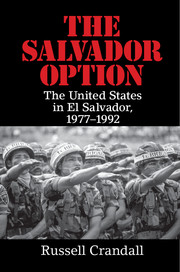Book contents
- Frontmatter
- Dedication
- Epigraph
- Contents
- List of Figures
- List of Organizations
- Acknowledgments
- 1 Introduction
- PART ONE EL SALVADOR IN THE COLD WAR
- 2 Farabundo Martí, La Matanza, and a Stolen Election
- 3 The United States in Latin America
- 4 American Military Mission in El Salvador
- 5 A Divided Nation: Military Traditions, Democratic Third Way, and Liberation Theology
- 6 Guerrillas Are Born
- PART TWO JIMMY CARTER
- PART THREE RONALD REAGAN
- PART FOUR GEORGE H. W. BUSH
- PART FIVE POSTWAR
- Notes
- Bibliography
- Index
5 - A Divided Nation: Military Traditions, Democratic Third Way, and Liberation Theology
from PART ONE - EL SALVADOR IN THE COLD WAR
Published online by Cambridge University Press: 05 June 2016
- Frontmatter
- Dedication
- Epigraph
- Contents
- List of Figures
- List of Organizations
- Acknowledgments
- 1 Introduction
- PART ONE EL SALVADOR IN THE COLD WAR
- 2 Farabundo Martí, La Matanza, and a Stolen Election
- 3 The United States in Latin America
- 4 American Military Mission in El Salvador
- 5 A Divided Nation: Military Traditions, Democratic Third Way, and Liberation Theology
- 6 Guerrillas Are Born
- PART TWO JIMMY CARTER
- PART THREE RONALD REAGAN
- PART FOUR GEORGE H. W. BUSH
- PART FIVE POSTWAR
- Notes
- Bibliography
- Index
Summary
[It was in the] “Third World,” that the Church would discover what it really was and what it really had to do.
– Enrique Krauze, Mexican historianThe rebels spared no effort to impress the American visitors, providing ample meals of steak, fresh orange juice and baked bread, as well as beds, a video television screen and trucks for transportation. A well-known revolutionary priest, Miguel Ventura, offered a mass in the bullet-pocked local church. A rebel chorus sang hymns of liberation theology. The first song began: “Christ, Christ Jesus, identify yourself with us. Have solidarity with us, not with the oppressor class, with us.”
– James LeMoyne, New York Times correspondent, reporting from guerrilla-controlled territory, 1985Once you had to be a colonel to get rich, now even the lower ranks steal.
– Joaquín Ventura, retired Salvadoran Army captain, December 1989Las Catorce
The decades leading up to the civil war were a tumultuous time that up-ended El Salvador's relatively predictable and stable political climate. To give a full sense of this harrowing story, this chapter addresses several key actors and movements that emerged on the left, right, and center of Salvadoran politics and society in the 1960s and ’70s. It seems appropriate to begin with the power that stood the test of time in this tiny Central American country – the oligarchy.
When foreign journalists during the war years wrote about the Salvadoran oligarchy, they almost invariably used the term “las catorce” for the fourteen families that were said to rule the country. The revolutionary left also described the oligarchs in such terms. According to one guerrilla leader interviewed in Havana in 1980, “Some 14 families own most of the land in El Salvador. These families are also linked to North American capital through the interests they have in the American-controlled industries.”
While the term las catorce was widely used, there were in fact around 100 clans that were the effective owners of Salvadoran industries and land. But even that number was suspect as some contended that it was in fact much larger, even if a tiny fraction compared to the country's total population. According to Jorge Sol Castellanos, a 66-year-old businessman and minister of the economy, “It's different from an aristocracy, which we also have. It's an oligarchy because these families own and run almost everything that makes money in El Salvador.
- Type
- Chapter
- Information
- The Salvador OptionThe United States in El Salvador, 1977–1992, pp. 46 - 64Publisher: Cambridge University PressPrint publication year: 2016

